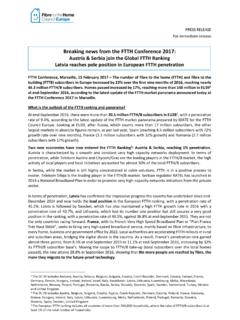Transcription of New FTTH-based Technologies and Applications
1 New FTTH-based Technologies and Applications A White Paper by the Deployment & Operations Committee Contributors: Jos Salgado (PT Inova o), Rong Zhao (Detecon International), and Nuno Monteiro (PT Inova o). Editor: Pauline Rigby Table of Contents Introduction .. 3. Drivers for Increased Bandwidth Demand .. 3. PON Standards Development .. 5. Next-generation PON Evolution .. 6. XG-PON1 .. 6. NG-PON2 .. 8. GPON to NG-PON2 Transition .. 10. Beyond NG-PON2 .. 11. NG-PON2 Applications .. 12. Small Cell Backhaul .. 12. C-RAN Architectures .. 13. Conclusions and Recommendations .. 15. References .. 16. Table of Figures Figure 1: Mobile data traffic growth. Source Cisco VNI Mobile Forecast, 2013 .. 4. Figure 2: Optical access standards evolution .. 5. Figure 3: ITU-T wavelength plan .. 6. Figure 4: Main features of XG-PON1 ITU-T .. 7. Figure 5: TWDM-PON architecture .. 8. Figure 6: Coexistence element (draft ITU-T ).. 9. Figure 8: Current GPON deployment .. 10. Figure 9: Coexistence of GPON and NG-PON2.
2 11. Figure 7: Beyond NG-PON2 - as envisioned by Analysys Mason, 12. Figure 10: Current CPRI backhaul topology .. 13. Figure 11: Dedicated wavelength for CPRI .. 14. 2. Introduction The evolution of fibre to the home ( ftth ) technology is a key issue for the telecom industry. Operators need to consider today which optical access platform will allow them to adapt most cost- effectively and intelligently as future bandwidth demand and Applications evolve. And, as the massive deployment of ftth networks continues worldwide, operators expect more from ftth - based Technologies . They expect next-generation Technologies to enhance bandwidth and service support capabilities while supporting coexistence with their existing equipment and outside plant. There are two main technical approaches to delivering ftth . A point-to-point Ethernet network provides each user with a dedicated optical channel. However, the passive optical network (PON), which provides point-to-multipoint connectivity, has become increasingly popular because it enables operators to make more efficient use of their optical fibre infrastructure.
3 Two flavours of PON exist: Ethernet PON (EPON) and Gigabit PON (GPON). PON has been widely deployed around the world. In Europe, early adopters and smaller operators have installed point-to-point Ethernet networks, but GPON is rapidly becoming the preferred choice among major operators. GPON is already the dominant technology choice in North America. Asia saw significant EPON deployments in Japan and South Korea, and China the world's largest ftth market recently embarked on a large-scale deployment using a mix of EPON and GPON. This white paper will consider the optimum evolutionary path of FTTH-based Technologies within the framework of next-generation PON, and the Applications that will drive this evolution. Drivers for Increased Bandwidth Demand Today, commercial triple-play service packages offer typical bandwidths between 20 and 100. Mbps to residential customers. According to Nielsen's Law, which predicts that a high-end user's Internet connection increases by 50 percent every year, one can envisage that a subscriber enjoying a 58-Mbps service in 2013 would require 130 Mbps by the year 2016.
4 In addition, the European Commission has set a target that by 2020 half of all households in Europe should have broadband subscriptions at speeds of at least 100 Mbps. Although current Technologies , such as GPON, will easily meet the short- to medium-term needs of residential consumers, over the longer term they will struggle to answer the requirements of highly demanding services like HDTV, 3D-TV, multiple image and angle video services, growth in unicast video (versus multicast), cloud computing, telepresence, multiplayer HD video gaming and more. 3. It is anticipated that the highest bandwidth demands will come from business users and mobile backhaul, which are already starting to take advantage of ftth networks to deliver their data content. The higher bandwidth available via optical access networks represents an attractive, lower cost option compared to a leased line or dedicated point-to-point Ethernet connection. By 2020 it is estimated that there will be 50 billion connected devices using the fixed and mobile broadband network.
5 This will create the networked society, in which everything benefiting from a connection will have one. From 2012 to 2017 the total amount of data exchanged between mobile users is expected to increase by 66 percent annually, according to Cisco's Visual Networking Index. The tremendous growth in mobile data will place huge pressure on operators. Exabytes per month 12 10. 8 6. 4. 2 0. 2012 2013 2014 2015 2016 2017. Figure 1: Mobile data traffic growth. Source Cisco VNI Mobile Forecast, 2013. Business services and mobile backhaul are expected to require sustained, symmetric data rates of 1 Gbps and beyond, while residential customers may be less demanding because require the peak bandwidths for shorter durations. Symmetric high-bandwidth pipes are not usually available over current-generation ftth networks however, due to lack of bandwidth resources and the asymmetric design of existing PON Technologies . Next-generation PON will address this issue while also providing the higher bandwidth and quality of service levels that these services require.
6 Convergence of voice and data service on a single optical network has proven to be the right choice for regional and core networks; similar efficiencies could be achieved in the access network. Larger split ratios, increased range, wavelength availability and fibre reuse can enable operators to serve more customers with less investment. Next-generation PONs will enable the smooth evolution from existing optical access networks, which are mainly residential, to converged access networks comprising residential, business services and mobile backhaul. 4. PON Standards Development The Institute of Electrical and Electronics Engineers (IEEE) developed the Ethernet in the First Mile (IEEE 2004) family of standards, which includes EPON. The 10-Gbps version, 10G- EPON, was ratified in 2009, as IEEE The standard supports two configurations: asymmetric, operating at 10 Gbps in the downstream (provider to customer) direction and 1 Gbps upstream (consumer to provider); and symmetric, operating at 10 Gbps in both directions.
7 Meanwhile, the special interest group Full Service Access Network (FSAN) has been leading GPON technology development, passing the work to the ITU Telecommunication Standardization Sector (ITU-T) when it the technical requirements are stable and ready for standardization. In 2006, FSAN/ITU-T began to consider the system that would follow GPON. Initially, the focus of this work was to develop additional specifications for the GPON system that would enable a smoother migration to whatever system came later. This work resulted in the recommendation, which refined the spectrum plan for GPON and defined blocking filters in the GPON optical network units (ONTs) to prevent crosstalk from non-GPON wavelengths. In 2007, the focus moved towards defining the new system itself. A wide range of technical options were raised as candidates, many of which were quite different in architecture and service profile from GPON. Finally, in 2010, ITU-T Recommendation : 10-Gigabit-capable passive optical network (XG-PON) systems, was defined, based on a TDM-PON architecture.
8 Figure 2: Optical access standards evolution 5. Since the optical distribution network represents approximately 70% of total investments in ftth . networks, it is crucial that future IEEE and ITU-T standards are backwards compatible, enabling operators to re-use their existing investments. Both the IEEE and ITU-T standards allow the coexistence of different generations of PON. technology. However, the proposed NG-PON2 standard already offers a clear path to higher capacities, and therefore is expected to better address the needs of operators in the future. Next-generation PON Evolution XG-PON1. The XG-PON1 approach, defined by ITU-T for near term deployment, operates with existing optical distribution networks and equipment. It provides 10 Gbps of shared downstream bandwidth, combined with Gbps of upstream bandwidth. XG-PON1 inherits the framing and management from GPON. Full-service operation is provided via higher data rate and larger split while keeping a flattened network structure adding more features and capacity without adding complexity to the optical distribution network.
9 Driven by the 10G optical transceiver market and the available bands for achieving legacy compatibility, FSAN selected the XG-PON1 downstream wavelength of 1575nm and upstream wavelength around 1270nm. For GPON and XG-PON systems to coexist on the same network requires the addition of a wavelength coupler located at the central office, which has already been defined as WDM1r in ITU-T Figure 3: ITU-T wavelength plan GPON class B+ defines a 28dB power budget. Due to the addition of the WDM1r combiner, some slight additional loss was added to the XG-PON1 power budget, resulting in an equivalent 29 dB. budget. Additionally, XG-PON1 specifies 31, 33, and 35 dB options for the power budget. 6. A potential barrier to the deployment of GPON and XG-PON1 on the same outside plant is the existence (or non-existence) of wavelength blocking filters at the optical networking terminals (ONTs) in the customer premises. Most modern GPON ONTs have an integrated filter to eliminate interference from XG-PON1 wavelengths.
10 However, older installed ONTs won't have such a filter. Service providers with older ONTs deployed will have to install filters at the ONT locations to enable GPON and XG-PON1 co-existence. For configuration, operation and maintenance, GPON and XG-PON use the same, generic Optical network unit Management and Control Interface (OMCI), specified in ITU-T Main features of XG-PON1. Optical fibre Single fibre transmission, compliant with ITU-T Wavelength plan Upstream 1260nm to 1280nm / downstream 1575nm to 1580nm Bandwidth Downstream: Up to10 Gbps / Upstream: Up to Support for dynamic bandwidth allocation (DBA). Full QoS and traffic management Nominal line rate Upstream: Gbps / downstream: Gbps Media access control layer Upstream: TDMA / Downstream: TDM. Forward error correction with scrambled NRZ line encoding Optical power budget Between 29 dB and 35 dB. Split ratio 1:32, 1:64, scalable up to 1:256. Fibre distance Differential distance of 20 km or 40 km. Logical Distance of up to 60 km.







